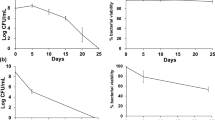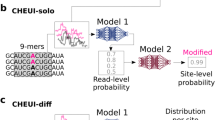Abstract
Previous work has shown that thiophosphate, a phosphate analogue, leads to a global shift in the distribution of cellular proteins in a variety of organisms. Thiophosphate, when added to culture media, gets incorporated into the nucleic acids of cells resulting in nuclease-resistant phosphorothioate linkages. Using Escherichia coli, as a model organism, it was found that the global changes in protein expression induced with thiophosphate could be accounted for by significant changes in the absolute transcription levels of more than 1500 genes detected via RNA seq analysis. In fact, 58% of transcripts detected in RNA seq studies using total RNA were increased an average of 44 × fold while the remaining 42% were decreased an average of 20 × fold in thiophosphate-treated cells. Furthermore, microarray results showed no correlation between the transcriptional changes observed and the known stability of the corresponding mRNAs measured. Overall, the total amount of non-ribosomal RNA accumulated in TP-treated cells was increased relative to rRNA ~ 4 × fold (1.5–6 ×). The results further indicated that metabolic changes may play a role in inducing the transcriptional profiles observed with thiophosphate. Indeed, pathway analysis of transcripts showed an increase in routes for phosphoribosyl pyrophosphate (PRPP) synthesis and related derivatives, presumably due to a reduction in RNA turnover. These results raise the possibility that the energy savings with reduced RNA turnover could lead to an increased energy charge in the cell that induces transcriptional changes leading to an increase in biosynthetic processes.



Similar content being viewed by others
Abbreviations
- TP:
-
Thiophosphate
- NT:
-
Nucleotide
- PRPP:
-
Phosphoribosyl pyrophosphate
- LB:
-
Luria broth
- AICAR:
-
5-Aminoimidazole-4-carboxamide ribonucleotide
References
Frayne EG (2016) Conserved mechanism of action of a phosphate analogue. Mol Cell Biochem 415:111–117. https//:doi:10.1007/s11010-016-2681-6
Frayne EG (2013) Global alterations in the secretomes of Bacillus subtilis and S. cerevisiae. In: Proceedings of the Annual Meeting of the American Institute of Chemical Engineers, San Francisco, CA.
Kala A, Friedman SH (2011) Enhanced light-activated RNA interference using phosphorothioate-based dsRNA precursors of siRNA. Pharm Res 28(12):3050–3057. https://doi.org/10.1007/s11095-011-0529-z
Jahns H, Roos M, Imig J, Baumann F, Wang Y, Gilmour R, Hall J (2015) Stereochemical bias introduced during RNA synthesis modulates the activity of phosphorothioate siRNAs. Nat Commun 6:6317. https://doi.org/10.1038/ncomms7317
Ledezma-Tejeida D, Altamirano-Pacheco L, Fajardo V, Collado-Vides J (2019) Limits to a classic paradigm: most transcription factors in E. coli regulate genes involved in multiple biological processes. Nucleic Acids Res 47(13):6656–6667. https://doi.org/10.1093/nar/gkz525
Wang Z, Gerstein M, Snyder M (2009) RNA-Seq: a revolutionary tool for transcriptomics. Nat Rev Genetics 10(1):57–63. https://doi.org/10.1038/nrg2484
Keseler IM, Mackie A, Santos-Zavaleta A, Billington R, Bonavides-Martinez C, Caspi R, Fulcher C, Gama-Castro S, Kothari A, Krummenacker M, Latendresse M, Muñiz-Rascado L, Ong Q, Paley S, Peralta-Gil M, Subhraveti P, Velazquez-Ramirez DA, Weaver D, Collado-Vides J, Paulsen I (2017) Karp PD (2019) The EcoCyc database: reflecting new knowledge about Escherichia coli K-12. Nucleic Acids Res 45:D543–550
Paley et al (2017) The Omics Dashboard for interactive exploration of gene-expression data. Nucleic Acids Res 45:12113–12124. https://doi.org/10.1093/nar/gkx910
Irizarry RA, Hobbs B, Collin F, Beazer-Barclay YD, Antonellis KJ, Scherf U, Speed TP (2003) Exploration, normalization, and summaries of high density oligonucleotide array probe level data. Biostatistics 4(2): 249–64. https//doi:10.1093/biostatistics/4.2.249
Agilent Technologies (2015) Agilent High Sensitivity RNA ScreenTape System Quick Guide. https://www.agilent.com/cs/library/usermanuals/public/ScreenTape_HSRNA_QG.pdf
Illumina (2010) TrueSeq RNA Sample Preparation Guide. https://genome.med.harvard.edu/documents/illumina/TruSeq_mRNA_SamplePrep_Guide.pdf
Trapnell C, Roberts A, Goff L, Pertea G, Kim D, Kelley DR, Pimentel H, Salzberg SL, Rinn JL, Pachter L (2012) Differential gene and transcript expression analysis of RNA-seq experiments with TopHat and Cufflinks. Nat Protoc 7(3):562–578. https://doi.org/10.1038/nprot.2012.016
Pertea M, Pertea GM, Antonescu CM, Chang TC, Mendell JT, Salzberg SL, (2015) StringTie enables improved reconstruction of a transcriptome from RNA-seq reads. Nat Biotechnol 33(3): 290–5. https//doi: 10.1038/nbt.3122
Petrova OE, Garcia-Alcalde F, Zampaloni C, Sauer K (2017) Comparative evaluation of rRNA depletion procedures for the improved analysis of bacterial biofilm and mixed pathogen culture transcriptomes. Sci Rep 7:41114
Milo R, Phillips R (2015) Cell biology by the numbers. CRC Press, Indianapolis. Available from https://book.bionumbers.org/what-is-the-macromolecular-composition-of-the-cell/
Wang M, Herrmann CJ, Simonovic M, Szklarczyk D, von Mering C (2015) Version 4.0 of PaxDb: protein abundance data, integrated across model organisms, tissues, and cell-lines. Proteomics 15(18): 3163–8. https//:doi: 10.1002/pmic.2014004412015, 10.1002/pmic.201400441
Selinger DW, Saxena RM, Cheung KJ, Church GM, Rosenow C (2003) Global RNA half-life analysis in Escherichia coli reveals positional patterns of transcript degradation. Genome Res 13:216–233. https//:doi: 10.1101/gr.912603
Mi H, Huang X, Muruganujan A, Tang H, Mills C, Kang D, Thomas PD (2019) PANTHER version 14: more genomes, a new PANTHER GO-slim and improvements in enrichment analysis tools. Nucleic Acids Res 47(D1):D419–D426
The Gene Ontology Consortium (2019) The gene ontology resource: 20 years and still GOing strong. Nucleic Acids Res 47(D1):D330–D338
Ohara M, Wu HC, Sankaran K, Rick PD (1999) Identification and characterization of a new lipoprotein, NlpI, in Escherichia coli K-12. J Bacteriol 181(14):4318–4325
Gottschalk G (1988) Bacterial Metabolism, 2nd edn. Springer, New York
Frayne E (2018) Increase in the Synthetic Pathways for RNA, Tryptophan, Fatty Acids, and Isoprenoids in Thio-phosphate Treated E. coli. In: Proceedings of the Annual Meeting of the American Institute of Chemical Engineers, Scottsdale, AZ.
Acknowledgements
I wish to thank Yuriy Alekseyev, Ph.D., Director, Boston University Microarray and Sequencing Resource at BUSM for assistance with the microarray study and the CTSA grant#1UL1TR001430 which helps to fund the BUSM facility. I also wish to thank Wenzhi Li, M.D. of Omega Bioservices for help with the RNA Seq study. Finally, I wish to acknowledge a research grant from the University of Phoenix, in partial support of this work. Thiophosphate was prepared by Frayne Consultants.
Author information
Authors and Affiliations
Corresponding author
Additional information
Publisher's Note
Springer Nature remains neutral with regard to jurisdictional claims in published maps and institutional affiliations.
Electronic supplementary material
Below is the link to the electronic supplementary material.
Rights and permissions
About this article
Cite this article
Frayne, E.G. Global profile changes in transcripts induced with a phosphate analogue: implications for gene regulation. Mol Cell Biochem 468, 111–120 (2020). https://doi.org/10.1007/s11010-020-03715-9
Received:
Accepted:
Published:
Issue Date:
DOI: https://doi.org/10.1007/s11010-020-03715-9




